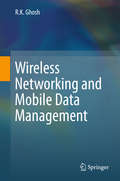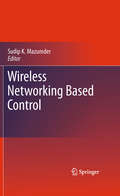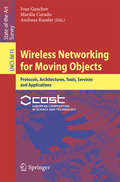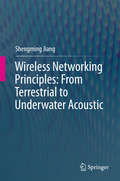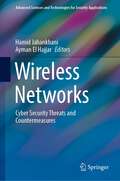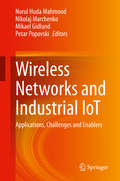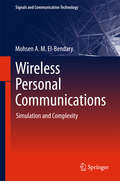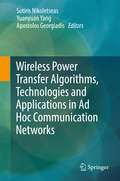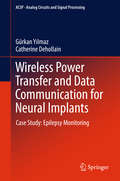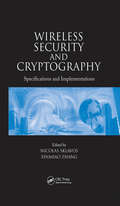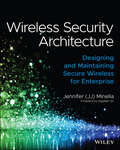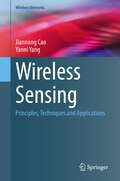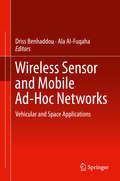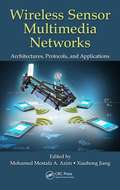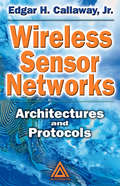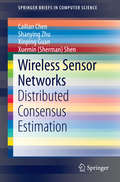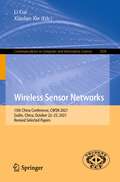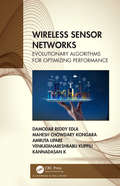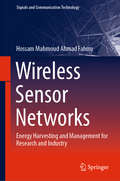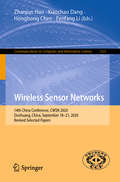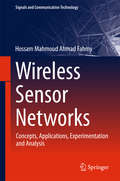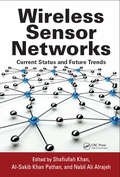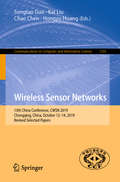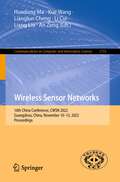- Table View
- List View
Wireless Networking and Mobile Data Management
by R. K. GhoshThis book examines two main topics, namely, Wireless Networking and Mobile Data Management. It is designed around a course the author began teaching to senior undergraduate and master's students at the Department of Computer Science & Engineering of the Indian Institute of Technology Kanpur. The first part of the book, consisting of eight chapters, including the introduction, focuses exclusively on wireless networking aspects. It begins with cellular communication systems, which provided the foundation of wireless networking principles. Three subsequent chapters are devoted to the Global System for Mobile communication (GSM), Wireless Local Area Network (WLAN), Bluetooth, infrared (IR), ZigBee and 6LoWPAN protocols. There is also a chapter on routings in ad hoc networks, an area that is currently being intensively researched due to its potential applications in areas of vehicular network, traffic management, tactical and military systems. Furthermore, the book discusses mobile operating systems and wireless network application level protocols such as Wireless Application Protocols (WAP), Mobile IP and Mosh. The second part highlights mobile data management. It addresses the issues like location management, the importance of replication and caching in mobile environments, the concept of broadcast disk and indexing in air, storage systems for sharing data in mobile environments, and building smart environments. Given that the design of algorithms is the key to applications in data management; this part begins with a chapter on the type of paradigm shift that has been introduced in the design of algorithms, especially due to asymmetry in mobile environments. Lastly, the closing chapter of the book explores smart environments, showing the readers how wireless technology and mobile data management can be combined to provide optimum comfort for human life. Though the book has been structured as a monograph, it can be used both as a textbook and as a reference material for researchers and developers working in the area.
Wireless Networking Based Control
by Sudip K. MazumderThis book will have a broad appeal in the area of Wireless Networking-Based Control. Various engineering disciplines, control and communication science organizations will be interested in purchasing the book with a new, emerging, and important theme. Also, industry such as Honeywell and those (e.g. power industry, automotive industry, aerospace industry) interested in implementing wireless network control to express interest in purchasing this book.
Wireless Networking for Moving Objects: Protocols, Architectures, Tools, Services and Applications (Lecture Notes in Computer Science #8611)
by Ivan Ganchev, Marília Curado and Andreas KasslerWireless networks of moving objects have drawn significant attention recently. These types of networks consist of a number of autonomous or semi-autonomous wireless nodes/objects moving with diverse patterns and speeds while communicating via several radio interfaces simultaneously. To overcome current shortcomings, a number of research challenges have to be addressed in this area, ranging from initial conceptualization and modelling, to protocols and architectures engineering, and development of suitable tools, applications and services, and to the elaboration of realistic use-case scenarios by taking into account corresponding societal and economic aspects. By applying a systematic approach the objective of this book is to assess the state of the art and consolidate the main research results achieved in this area. It was prepared as the Final Publication of the COST Action IC0906 “Wireless Networking for Moving Objects (WiNeMO)”. The book contains 15 chapters and is a show-case of the main outcomes of the action in line with its scientific goals. The book will serve as a valuable reference for undergraduate students, post-graduate students, educators, faculty members, researchers, engineers, and research strategists working in this field.
Wireless Networking Principles: From Terrestrial to Underwater Acoustic
by Shengming JiangThis book systematically summarizes the fundamentals and various technologies in both terrestrial radio wireless networks and underwater acoustic networks (UWANs). It addresses the basic issues frequently investigated in terrestrial radio wireless networks and the key technologies suitable for the newly developing research area of UWANs. Starting with a review of our current understanding of wireless networks, it then introduces the principles of the main technologies, including error control, medium access control (MAC) protocols, routing protocols, end-to-end transmission control and mobility issues as well as network security for terrestrial radio wireless networks, and offers detailed surveys of these technologies for UWANs.Providing readers with the basic knowledge of terrestrial radio wireless networking technologies and raising readers’ awareness of the developing topic of UWANs in ocean , it is a valuable resource for researchers and practitioners in terrestrial radio wireless networks and UWANs.
Wireless Networks: Cyber Security Threats and Countermeasures (Advanced Sciences and Technologies for Security Applications)
by Hamid Jahankhani Ayman El HajjarIn recent years, wireless networks communication has become the fundamental basis of our work, leisure, and communication life from the early GSM mobile phones to the Internet of Things and Internet of Everything communications. All wireless communications technologies such as Bluetooth, NFC, wireless sensors, wireless LANs, ZigBee, GSM, and others have their own challenges and security threats. This book addresses some of these challenges focusing on the implication, impact, and mitigations of the stated issues. The book provides a comprehensive coverage of not only the technical and ethical issues presented by the use of wireless networks but also the adversarial application of wireless networks and its associated implications. The authors recommend a number of novel approaches to assist in better detecting, thwarting, and addressing wireless challenges and threats. The book also looks ahead and forecasts what attacks can be carried out in the future through the malicious use of the wireless networks if sufficient defenses are not implemented. The research contained in the book fits well into the larger body of work on various aspects of wireless networks and cyber-security. The book provides a valuable reference for cyber-security experts, practitioners, and network security professionals, particularly those interested in the security of the various wireless networks. It is also aimed at researchers seeking to obtain a more profound knowledge in various types of wireless networks in the context of cyber-security, wireless networks, and cybercrime. Furthermore, the book is an exceptional advanced text for Ph.D. and master’s degree programs in cyber-security, network security, cyber-terrorism, and computer science who are investigating or evaluating a security of a specific wireless network. Each chapter is written by an internationally-renowned expert who has extensive experience in law enforcement, industry, or academia. Furthermore, this book blends advanced research findings with practice-based methods to provide the reader with advanced understanding and relevant skills.
Wireless Networks and Industrial IoT: Applications, Challenges and Enablers
by Nurul Huda Mahmood Nikolaj Marchenko Mikael Gidlund Petar PopovskiThis book provides a comprehensive overview of the most relevant research and standardization results in the area of wireless networking for Industrial IoT, covering both critical and massive connectivity. Most chapters in this book are intended to serve as short tutorials of particular topics, highlighting the main developments and ideas, as well as giving an outlook of the upcoming research challenges.The book is divided into four parts. The first part focuses on challenges, enablers and standardization efforts for reliable low-latency communication in Industrial IoT networks. The next part focuses on massive IoT, which requires cost- and energy-efficient technology components to efficiently connect a massive number of low-cost IoT devices. The third part covers three enabling technologies in the context of Industrial IoT: Security, Machine Learning/Artificial Intelligence and Edge Computing. These enablers are applicable to both connectivity types, critical and massive IoT. The last part covers aspects of Industrial IoT related to connected transportation that are important in, for example, warehouse and port logistics, product delivery and transportation among industries.Presents a comprehensive guide to concepts and research challenges in wireless networking for Industrial IoT;Includes an introduction and overview of such topics as 3GPP standardization for Industrial IoT, Time Sensitive Networking, system dependability over wireless networks, energy-efficient wireless networks, IoT security, ML/AI for Industrial IoT and connected transportation systems;Features contributions by well-recognized experts from both academia and industry.
Wireless Personal Communications: Simulation And Complexity (Signals And Communication Technology)
by Mohsen A. M. El-BendaryThis book introduces wireless personal communications from the point of view of wireless communication system researchers. Existing sources on wireless communications put more emphasis on simulation and fundamental principles of how to build a study model. In this volume, the aim is to pass on to readers as much knowledge as is essential for completing model building of wireless communications, focusing on wireless personal area networks (WPANs). This book is the first of its kind that gives step-by-step details on how to build the WPANs simulation model. It is most helpful for readers to get a clear picture of the whole wireless simulation model by being presented with many study models. The book is also the first treatise on wireless communication that gives a comprehensive introduction to data-length complexity and the computational complexity of the processed data and the error control schemes. This volume is useful for all academic and technical staff in the fields of telecommunications and wireless communications, as it presents many scenarios for enhancing techniques for weak error control performance and other scenarios for complexity reduction of the wireless data and image transmission. Many examples are given to help readers to understand the material covered in the book. Additional resources such as the MATLAB codes for some of the examples also are presented.
Wireless Power Transfer Algorithms, Technologies and Applications in Ad Hoc Communication Networks
by Sotiris Nikoletseas Yuanyuan Yang Apostolos GeorgiadisThis book is the first systematic exposition on the emerging domain of wireless power transfer in ad hoc communication networks. It selectively spans a coherent, large spectrum of fundamental aspects of wireless power transfer, such as mobility management in the network, combined wireless power and information transfer, energy flow among network devices, joint activities with wireless power transfer (routing, data gathering and solar energy harvesting), and safety provisioning through electromagnetic radiation control, as well as fundamental and novel circuits and technologies enabling the wide application of wireless powering. Comprising a total of 27 chapters, contributed by leading experts, the content is organized into six thematic sections: technologies, communication, mobility, energy flow, joint operations, and electromagnetic radiation awareness. It will be valuable for researchers, engineers, educators, and students, and it may also be used as a supplement to academic courses on algorithmic applications, wireless protocols, distributed computing, and networking.
Wireless Power Transfer and Data Communication for Neural Implants
by Gürkan Yilmaz Catherine DehollainThis book presents new circuits and systems for implantable biomedical applications targeting neural recording. The authors describe a system design adapted to conform to the requirements of an epilepsy monitoring system. Throughout the book, these requirements are reflected in terms of implant size, power consumption, and data rate. In addition to theoretical background which explains the relevant technical challenges, the authors provide practical, step-by-step solutions to these problems. Readers will gain understanding of the numerical values in such a system, enabling projections for feasibility of new projects.
Wireless-Powered Communication Networks: Architectures, Protocols, and Applications
by Dusit Niyato Ekram Hossain Dong In Kim Vijay Bhargava Lotfollah ShafaiLearn the fundamentals of architecture design, protocol optimization, and application development for wireless-powered communication networks with this authoritative guide. Readers will gain a detailed understanding of the issues surrounding architecture and protocol design, with key topics covered including relay-based energy harvesting systems, multiple-antenna systems for simultaneous wireless information and power transfer (SWIPT), performance modeling and analysis, and ambient wireless energy harvesting based cellular systems. Current applications of energy harvesting and transfer in different wireless networking scenarios are discussed, aiding the understanding of practical system development and implementation issues from an engineering perspective. The first book to provide a unified view of energy harvesting and wireless power transfer networks from a communications perspective, this is an essential text for researchers working on wireless communication networks and wireless systems, RF engineers, and wireless application developers.
Wireless Security and Cryptography: Specifications and Implementations
by Nicolas Sklavos Xinmiao ZhangAs the use of wireless devices becomes widespread, so does the need for strong and secure transport protocols. Even with this intensified need for securing systems, using cryptography does not seem to be a viable solution due to difficulties in implementation. The security layers of many wireless protocols use outdated encryption algorithms, which have proven unsuitable for hardware usage, particularly with handheld devices. Summarizing key issues involved in achieving desirable performance in security implementations, Wireless Security and Cryptography: Specifications and Implementations focuses on alternative integration approaches for wireless communication security. It gives an overview of the current security layer of wireless protocols and presents the performance characteristics of implementations in both software and hardware. This resource also presents efficient and novel methods to execute security schemes in wireless protocols with high performance. It provides the state of the art research trends in implementations of wireless protocol security for current and future wireless communications. Unique in its coverage of specification and implementation concerns that include hardware design techniques, Wireless Security and Cryptography: Specifications and Implementations provides thorough coverage of wireless network security and recent research directions in the field.
Wireless Security Architecture: Designing and Maintaining Secure Wireless for Enterprise
by Jennifer MinellaReduce organizational cybersecurity risk and build comprehensive WiFi, private cellular, and IOT security solutions Wireless Security Architecture: Designing and Maintaining Secure Wireless for Enterprise offers readers an essential guide to planning, designing, and preserving secure wireless infrastructures. It is a blueprint to a resilient and compliant architecture that responds to regulatory requirements, reduces organizational risk, and conforms to industry best practices. This book emphasizes WiFi security, as well as guidance on private cellular and Internet of Things security. Readers will discover how to move beyond isolated technical certifications and vendor training and put together a coherent network that responds to contemporary security risks. It offers up-to-date coverage—including data published for the first time—of new WPA3 security, Wi-Fi 6E, zero-trust frameworks, and other emerging trends. It also includes: Concrete strategies suitable for organizations of all sizes, from large government agencies to small public and private companies Effective technical resources and real-world sample architectures Explorations of the relationships between security, wireless, and network elements Practical planning templates, guides, and real-world case studies demonstrating application of the included conceptsPerfect for network, wireless, and enterprise security architects, Wireless Security Architecture belongs in the libraries of technical leaders in firms of all sizes and in any industry seeking to build a secure wireless network.
Wireless Sensing: Principles, Techniques and Applications (Wireless Networks)
by Jiannong Cao Yanni YangThis book systematically presents the wireless sensing technology, which has become a promising sensing paradigm in recent years. It includes the introduction of underlying sensing principles, wireless signals, sensing methodologies and enabled applications. Meanwhile, it provides case studies to demonstrate how wireless sensing is applied for representative human and object sensing applications.This book also provides a wireless sensing framework as a guidance to understand and design a wireless sensing system or prototype based on their needs. It also presents a critical investigation of the challenges in achieving wireless sensing in both signal-level and application-level contexts. Accordingly, it summarizes the typical solutions to tackle the related challenges.Researchers and advanced-level students in computer science or electrical engineering working on the design of a wireless system will find this book useful as a reference. Professionals working in the wireless sensing industry will also find this book valuable as a reference tool.
Wireless Sensor and Mobile Ad-Hoc Networks
by Driss Benhaddou Ala Al-FuqahaWireless sensor Networks: Vehicle and Space Applications describes the practical perspectives in using wireless sensor networks (WSN) to develop real world applications that can be used for space exploration. These applications include sensor interfaces, remote wireless vehicles, space crew health monitoring and instrumentation. The material discusses how applications of WSN originally developed for space travel and exploration are being applied and used in multiple real world applications, allowing for the development of smart systems that have characteristics such as self healing, self diagnosis, and emergency healthcare notification.
Wireless Sensor Multimedia Networks: Architectures, Protocols, and Applications
by Mohamed Mostafa A. Azim Xiaohong JiangWireless sensor networks (WSNs) are a special class of ad hoc network in which network nodes composed of tiny sensors pass data such as temperature, pressure, and humidity through the network to a central location. Wireless sensor multimedia networks (WSMNs) are a special category of WSNs in which the sensor nodes are small cameras and microphones
Wireless Sensor Networks: Architectures and Protocols (Internet And Communications)
by Edgar Callaway Jr.Because they provide practical machine-to-machine communication at a very low cost, the popularity of wireless sensor networks is expected to skyrocket in the next few years, duplicating the recent explosion of wireless LANs. Wireless Sensor Networks: Architectures and Protocols describes how to build these networks.
Wireless Sensor Networks
by Cailian Chen Shanying Zhu Xinping Guan Xuemin Sherman ShenThis SpringerBrief evaluates the cooperative effort of sensor nodes to accomplish high-level tasks with sensing, data processing and communication. The metrics of network-wide convergence, unbiasedness, consistency and optimality are discussed through network topology, distributed estimation algorithms and consensus strategy. Systematic analysis reveals that proper deployment of sensor nodes and a small number of low-cost relays (without sensing function) can speed up the information fusion and thus improve the estimation capability of wireless sensor networks (WSNs). This brief also investigates the spatial distribution of sensor nodes and basic scalable estimation algorithms, the consensus-based estimation capability for a class of relay assisted sensor networks with asymmetric communication topology, and the problem of filter design for mobile target tracking over WSNs. From the system perspective, the network topology is closely related to the capability and efficiency of network-wide scalable distributed estimation. Wireless Sensor Networks: Distributed Consensus Estimation is a valuable resource for researchers and professionals working in wireless communications, networks and distributed computing. Advanced-level students studying computer science and electrical engineering will also find the content helpful.
Wireless Sensor Networks: 15th China Conference, CWSN 2021, Guilin, China, October 22–25, 2021, Revised Selected Papers (Communications in Computer and Information Science #1509)
by Li Cui Xiaolan XieThis book constitutes the refereed proceedings of the 15th China Conference on Wireless Sensor Networks, CWSN 2021 held in Guilin, China, in October 2021.The 19 papers were carefully reviewed and selected from 60 submissions. The papers are organized in topical sections on theory and technology on wireless sensor network; application on internet of things; security and privacy protection on internet of things; fog computing and wireless computing.
Wireless Sensor Networks: Evolutionary Algorithms for Optimizing Performance
by Damodar Reddy Edla Mahesh Chowdary Kongara Amruta Lipare Venkatanareshbabu Kuppili Kannadasan KWireless Sensor Networks: Evolutionary Algorithms for Optimizing Performance provides an integrative overview of bio-inspired algorithms and their applications in the area of Wireless Sensor Networks (WSN). Along with the usage of the WSN, the number of risks and challenges occurs while deploying any WSN. Therefore, to defeat these challenges some of the bio-inspired algorithms are applied and discussed in this book. Discussion includes a broad, integrated perspective on various challenges and issues in WSN and also impact of bio-inspired algorithms on the lifetime of the WSN. It creates interdisciplinary theory, concepts, definitions, models and findings involved in WSN and Bio-inspired algorithms making it an essential guide and reference. It includes various WSN examples making the book accessible to a broader interdisciplinary readership. The book offers comprehensive coverage of the most essential topics, including: Evolutionary algorithms Swarm intelligence Hybrid algorithms Energy efficiency in WSN Load balancing of gateways Localization Clustering and routing Designing fitness functions according to the issues in WSN. The book explains about practices of shuffled complex evolution algorithm, shuffled frog leaping algorithm, particle swarm optimization and dolphin swarm optimization to defeat various challenges in WSN. The author elucidates how we must transform our thinking, illuminating the benefits and opportunities offered by bio-inspired approaches to innovation and learning in the area of WSN. This book serves as a reference book for scientific investigators who shows an interest in evolutionary computation and swarm intelligence as well as issues and challenges in WSN.
Wireless Sensor Networks: Energy Harvesting and Management for Research and Industry (Signals and Communication Technology)
by Hossam Mahmoud FahmyThis second book by the author on WSNs focuses on the concepts of energy, and energy harvesting and management techniques. Definitions and terminologies are made clear without leaning on the relaxing assumption that they are already known or easily reachable, the reader is not to be diverted from the main course. Neatly drawn figures assist in viewing and imagining the offered topics. To make energy related topics felt and seen, the adopted technologies as well as their manufacturers are presented in details. With such a depth, this book is intended for a wide audience, it is meant to be helper and motivator, for the senior undergraduates, postgraduates, researchers, and practitioners; concepts and energy related applications are laid out, research and practical issues are backed by appropriate literature, and new trends are put under focus. For senior undergraduate students, it familiarizes with conceptual foundations and practical projects implementations. Also, it is intended for graduate students working on their thesis and in need of specific knowledge on WSNs and the related energy harvesting and management techniques. Moreover, it is targeting researchers and practitioners interested in features and applications of WSNs, and on the available energy harvesting and management projects and testbeds. Exercises at the end of each chapter are not just questions and answers; they are not limited to recapitulate ideas. Their design objective is not bound to be a methodical review of the provided concepts, but rather as a motivator for lot more of searching, finding, and comparing beyond what has been presented in the book.
Wireless Sensor Networks: 14th China Conference, CWSN 2020, Dunhuang, China, September 18–21, 2020, Revised Selected Papers (Communications in Computer and Information Science #1321)
by Zhanjun Hao Xiaochao Dang Honghong Chen Fenfang LiThis book constitutes the refereed proceedings of the 14th China Conference on Wireless Sensor Networks, CWSN 2020 held in Dunhuang, China, in September 2020.The 20 full papers were carefully reviewed and selected from 85 submissions. The papers are organized in topical sections on wireless sensor network theory and technology, basic theory and application of internet of things, internet of things security and privacy protection, and perception and positioning.
Wireless Sensor Networks
by Hossam Mahmoud Ahmad FahmyThisbook focuses on the principles of wireless sensor networks (WSNs), theirapplications, and their analysis tools, with meticulous attention paid todefinitions and terminology. This book presents the adopted technologies andtheir manufacturers in detail, making WSNs tangible for the reader. Inintroductory computer networking books, chapter sequencing follows thebottom-up or top-down architecture of the 7-layer protocol. This bookaddresses subsequent steps in this process, both horizontally and vertically,thus fostering a clearer and deeper understanding through chapters thatelaborate on WSN concepts and issues. With such depth, this book is intended for a wide audience; it ismeant to be a helper and motivator for senior undergraduates, postgraduates,researchers, and practitioners. It lays out important concepts and WSN-relateapplications; uses appropriate literature to back research and practicalissues; and focuses on new trends. Senior undergraduate students can use it tofamiliarize themselves with conceptual foundations and practical projectimplementations. For graduate students and researchers, test beds andsimulators provide vital insights into analysis methods and tools for WSNs. Lastly, in addition to applications and deployment, practitioners will be ableto learn more about WSN manufacturers and components within several platformsand test beds.
Wireless Sensor Networks: Current Status and Future Trends
by Shafiullah Khan Al-Sakib Khan Pathan Nabil Ali AlrajehWireless sensor networks (WSNs) utilize fast, cheap, and effective applications to imitate the human intelligence capability of sensing on a wider distributed scale. But acquiring data from the deployment area of a WSN is not always easy and multiple issues arise, including the limited resources of sensor devices run with one-time batteries. Additi
Wireless Sensor Networks: 13th China Conference, CWSN 2019, Chongqing, China, October 12–14, 2019, Revised Selected Papers (Communications in Computer and Information Science #1101)
by Kai Liu Chao Chen Songtao Guo Hongyu HuangThis book constitutes the refereed proceedings of the 13th China Conference on Wireless Sensor Networks, CWSN 2019, held in Chongqing, China, in October 2019. The 27 full papers were carefully reviewed and selected from 158 submissions. The papers are organized in topical sections on fundamentals on Internet of Things; applications on Internet of Things; and IntelliSense, location and tracking.
Wireless Sensor Networks: 16th China Conference, CWSN 2022, Guangzhou, China, November 10–13, 2022, Proceedings (Communications in Computer and Information Science #1715)
by Huadong Ma Xue Wang Lianglun Cheng Li Cui Liang Liu An ZengThis book constitutes the refereed proceedings of the 16th China Conference on Wireless Sensor Networks, CWSN 2022, which took place in Guangzhou, China, in November 2022. The 17 full papers presented in this volume were carefully reviewed and selected from 204 submissions, including 87 English papers and 117 Chinese papers. The conference provided an academic exchange of research and a development forum for IoT researchers, developers, enterprises, and users. Exchanging results and experience of research and applications in IoT, and discussing the key challenges and research hotspots, is the main goal of the forum. As a high-level forum for the design, implementation, and application of IoT, the conference promoted the exchange and application of the oriesand technologies of IoT-related topics.
